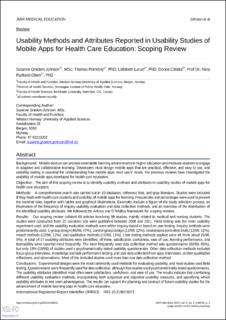| dc.identifier.citation | Johnson, S. G., Potrebny, T., Larun, L., Ciliska, D., & Olsen, N. R. (2022). Usability methods and attributes reported in usability studies of mobile apps for health care education: Scoping review. JMIR Medical Education, 8(2). | en_US |
| dc.description.abstract | Background:
Mobile devices can provide extendable learning environments in higher education and motivate students to engage in adaptive and collaborative learning. Developers must design mobile apps that are practical, effective, and easy to use, and usability testing is essential for understanding how mobile apps meet users’ needs. No previous reviews have investigated the usability of mobile apps developed for health care education.
Objective:
The aim of this scoping review is to identify usability methods and attributes in usability studies of mobile apps for health care education.
Methods:
A comprehensive search was carried out in 10 databases, reference lists, and gray literature. Studies were included if they dealt with health care students and usability of mobile apps for learning. Frequencies and percentages were used to present the nominal data, together with tables and graphical illustrations. Examples include a figure of the study selection process, an illustration of the frequency of inquiry usability evaluation and data collection methods, and an overview of the distribution of the identified usability attributes. We followed the Arksey and O’Malley framework for scoping reviews.
Results:
Our scoping review collated 88 articles involving 98 studies, mainly related to medical and nursing students. The studies were conducted from 22 countries and were published between 2008 and 2021. Field testing was the main usability experiment used, and the usability evaluation methods were either inquiry-based or based on user testing. Inquiry methods were predominantly used: 1-group design (46/98, 47%), control group design (12/98, 12%), randomized controlled trials (12/98, 12%), mixed methods (12/98, 12%), and qualitative methods (11/98, 11%). User testing methods applied were all think aloud (5/98, 5%). A total of 17 usability attributes were identified; of these, satisfaction, usefulness, ease of use, learning performance, and learnability were reported most frequently. The most frequently used data collection method was questionnaires (83/98, 85%), but only 19% (19/98) of studies used a psychometrically tested usability questionnaire. Other data collection methods included focus group interviews, knowledge and task performance testing, and user data collected from apps, interviews, written qualitative reflections, and observations. Most of the included studies used more than one data collection method.
Conclusions:
Experimental designs were the most commonly used methods for evaluating usability, and most studies used field testing. Questionnaires were frequently used for data collection, although few studies used psychometrically tested questionnaires. The usability attributes identified most often were satisfaction, usefulness, and ease of use. The results indicate that combining different usability evaluation methods, incorporating both subjective and objective usability measures, and specifying which usability attributes to test seem advantageous. The results can support the planning and conduct of future usability studies for the advancement of mobile learning apps in health care education. | en_US |

